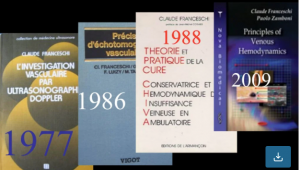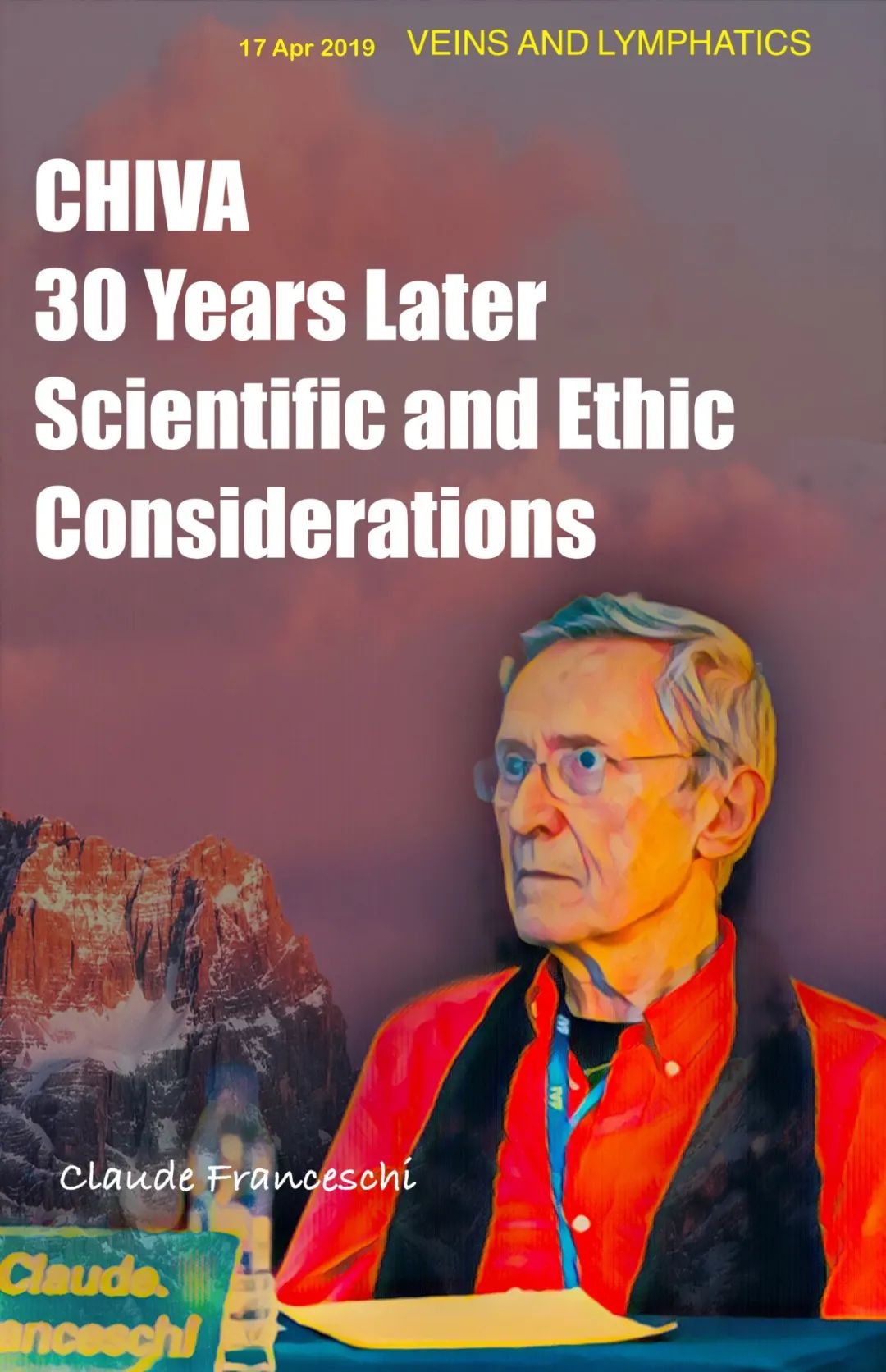
世界血流动力学先驱Franceschi教授
80年代,人类在静脉曲张治疗的历史上首次出现了保留静脉、基于血流动力学纠正的CHIVA治疗技术。CHIVA是法语Cure Conservatrice et Hemodynamique de l′Insufficience Veineuse en Ambulatoire的简称,该治疗理念由法国医生Franceschi创立。
CHIVA手术一反过去的破坏性、废弃性手术原理,通过超声对静脉血流动力进行详尽的分析,从源头上对异常的血流动力学进行纠正,是所有微创手术中对人体创伤最小,痛苦也最小。张强医生团队于2011年首次把CHIVA引入中国。2017年初,张强医生集团(Dr.Smile Medical Group)正式宣布旗下十多个城市的静脉病中心用CHIVA全面替代其他破坏性方法。

Franceschi教授在张强医生集团
2019年,CHIVA创始人Franceschi教授在《静脉和淋巴》发表特别文章“CHIVA30 年,科学和伦理。”,回顾了CHIVA过去30年的曲折道路。
在70年代、80年代,我们有越来越多的冠心病患者需要自身的大隐静脉用于冠状动脉搭桥。但不幸的是,之前的很多大隐静脉不幸被我们过去的手术或其它静脉腔内治疗破坏掉了。 我对我们的“精神分裂行为”感到吃惊:一方面破坏良性的静脉,另一方面,当我们需要它为危重患者进行静脉旁路时,却又为静脉缺失而遗憾。 所以,作为一名前精神科医生,我决定直面并“治疗”我自己的“精神错乱”。除了采用足部抬高、包扎和弹力袜等保守治疗外,我还试图找到一种手术治疗,可以保留静脉。 我观察到当病人的脚抬高或平卧时,曲张的静脉会消失。结合Trendelenburg 和Perthes试验的效果,让我想到:静脉功能不全的根本原因及跨其作为静脉曲张的症状,背后的原因只是静脉的血流动力学发生障碍、压力增高。 基于这些观察,加上Bjordal教授等对静脉压力的研究成果,以及超声设备和技术的革命性进步,我们可以更好地了解静脉系统及其异常的血流动力学改变。 医学界由此产生了静脉系统的病理生理血流动力学理论,如静水压的动态分割、各种静脉分流(SHUNT)模式、回流(Re-entry)概念、跨壁压控制作为所有合理治疗的目标、定位盆腔渗漏点(pelvic leak)、描绘血流动力学地图,最后是保护患者的静脉网络,用于正确引流并预防复发。 这些概念是 CHIVA 治疗的基础,发表于 1988 年。 由于传统壁垒的存在,CHIVA 曾经被视为具有挑衅性的胡说八道。因为到目前为止,静脉破坏性手术仍然占主导市场。近一个世纪以来,关于人类静脉曲张的研究和设备研发,都集中在破坏和杀死静脉上,并且错误地把治疗失败和复发都归因于遗留的静脉。 事实上,CHIVA 是基于一种截然不同的病理生理学观念。它的科学性得到了广泛的实验结果验证。感谢欧洲多家中心完成的数百项研究、包括一些 RCT 和 Cochrane 综述,都表明CHIVA 比破坏性治疗方法更成功,并且可以同时达到有效治疗静脉功能不全和保留静脉资源的两个目标。 学习CHIVA 也是一项科学和智力的挑战,需要颠覆传统的主流观念知识和个人思维惯性。无论是静脉血流动力学理论或是相关的多普勒超声评估技术,学习曲线都很漫长。即使棋盘完全相同(10对8 个方格),我们也不能用国际象棋的规则来下国际跳棋。CHIVA 也是如此。破坏性手术方法的规则不能用于保留血管的CHIVA。 各种保守或消融剥脱的方法,无论是侵入性或非侵入性的器械设备在市场营销上非常强势,但在医学上对患者并不公平。保守治疗方法也并非一定安全,只有在性价比超过手术时才是正确的选择。而CHIVA在门诊就可以方便地进行安全的微创治疗。 医生应基于医学证据来披露患者的风险和获益信息。做到这个其实非常容易,正如希波克拉底誓言所言:“我尽余之能力和判断力所及,遵守为病家谋利益之信条,并检柬一切堕落和害人行为。” 此外,患者知情同意书有义务告知所提议方案与其它替代方案的性质和目的、风险和获益。 不幸的是,现实有点骨感。我们要意识到无知、嘲讽、竞争、贪婪和利益冲突仍然在医疗界存在。 创造条件让静脉病医生更好地为病人提供信息和治疗,可以唤醒我们心中的《希波克拉底誓言》。提醒他们静脉曲张通常是良性的,可以根据他/她的美观或舒适期望,来选择治疗或不治疗。如果存在皮肤变化和溃疡,可以使用简单有效的降低透壁压力的方法来解决。此外,CHIVA 概念和策略同样可以适用于深静脉疾病,尤其是血栓形成后的疾病,也适用于部分静脉畸形。

Main Text In the seventies and eighties, we had more and more patients who needed a saphenous vein by-pass due to the fact that the previous one was unfortunately destroyed by a surgical or endo-venous treatment. I was struck by our schizophrenic behavior which consisted of, on the one hand, the saphenous vein destruction for the benign varicose disease and on the other hand, lamenting for its absence when we needed it to perform a venous by-pass for a critical or life-threatening arterial or coronary obstruction. So, as a former psychiatrist, I decide to confront and treat my insanity. In addition to conservative treatments as foot elevation, bandaging and compressive stocking, I tried to find a surgical treatment which could also preserve the saphenous capital. My observations of the varicose veins disappearance when I lifted the feet of my patients combined together with the Trendelenburg and Perthes maneuvers effects, convinced me that the cause of the venous insufficiency and its symptoms as the varicosity was just a hemodynamic impairment of the venous flows and pressure control.1-10 Then, on these grounds and thanks to the studies of the venous pressure mainly published by Bjordal and the revolutionary capability of recent EchoDoppler Ultrasound devices, I could figure out a better hemodynamics of the venous system and its anomalies. From all this, new proposals of venous pathophysiological hemodynamic principles resulted, as the Dynamic Fractioning of Hydrostatic pressure, various Venous Shunt patterns, Re-entry concept, Trans-mural Pressure control as the target of any rational treatment, location of not yet individualized pelvic leak points, hemodynamic venous cartography, and finally the necessary conservation of the venous network for a correct drainage of the tissues and prevention of recurrence. These concepts were the basis of the CHIVA treatment (French acronym for cure Conservatrice Hémodynamique de l’Insuffisance Veineuse en Ambulatoire) published in 1988. As Conservation is a pillar, CHIVA was received as provocative nonsense because, so far, the destructive paradigm was dominant. Indeed, for almost a century, research, studies and devices where focused on killing the veins because the treatment failures and recurrences where attributed to the veins left behind. Indeed, CHIVA is based on a dramatically different pathophysiological rational. Its concepts were verified by further experimental evidence. Thanks to hundreds of studies, some RCTs and a Cochrane review, achieved by various authors over Europe, CHIVA is today validated as more successful than destructive method and reaches at the same time, both targets of treating efficiently the venous insufficiency and preserving the venous capital for future by-pass.11-13CHIVA is also a scientific and intellectual challenge, which demands a reconsideration of the mainstream knowledge and personal habits, a steep learning curve of the appropriate venous hemodynamics and its related Duplex Scan assessment. We cannot play a game of chess with the rules for checkers even if the board is quite identical (10 vs 8 squares). The same is for CHIVA. The rules of destructive methods cannot fit the conservative CHIVA. Conservative or ablative methods, as well as invasive and non-invasive or laser and other advanced devices, are powerful marketing topics but not always medically fair. The Conservative procedures are relevant only when they are better than the ablative ones in terms of risks/benefits ratio. Non-invasive procedures are not necessarily safe. CHIVA is feasible in outpatients with mini-invasive surgery.8-10The patient information should point out the risks/benefits based on the medical evidence. That is like kicking down an open door if we refer to the Hippocratic Oath: ‘I follow that system of regimen which, according to my ability and judgment, I consider for the benefit of my patients, and abstain from whatever is deleterious and mischievous.’ Furthermore, the patient Informed Consent obliges to inform the patient about the nature and purpose, risks and benefits of the proposed treatment as well as the alternatives.Unfortunately, reality is not so good. Ignorance, cynicism, competition, greed and conflicts of interest shall still be taken into account.I would like to revive the fair Hippocratic Oath by permitting the phlebologist to better inform and treat the patient. Remind him that varicose veins are usually benign and may be treated or not according to his/her cosmetic or comfort expectation. In case of skin changes and ulcers, easy efficient procedures on transmural pressure decrease are available. In addition, the CHIVA concepts and strategy are applicable to the deep venous diseases, particularly post-thrombotic, and also to the venous malformations.
1. Varicose vein stripping vs haemodynamic correction (CHIVA): a long term randomised trialS CarandinaEur J Vasc Endovasc Surg, 35: 230-7, 2008
2. Varicose vein surgery: stripping versus the CHIVA Method: a randomized controlled trialJO ParésAnn Surg, 251: 624-31, 2010
3. Comparative study oftwo surgical techniques in the treatment of varicose veins of the lower extremities: results after five years of follow upE Iborra-OrtegaAngiología, 58: 459-68, 2006
4. Retrospective comparison of clinical outcomes between endovenous laser and saphenous vein-sparing surgery for treatment of varicose veinsC-Y ChanWorld J Surg, 35: 1679-86, 2011
5. Hemodynamic classification and CHIVAtreatment of varicose veins in lower extremities (VVLE)H WangInt J Clin Exp Med, 9: 2465-71, 2016
6. Morbidity and mortality after thermal venous ablationsRD MalgorInt Angiol, 35: 57-61, 2016
7. Minimally invasive surgical management of primary venous ulcers vs. compression treatment: a randomized clinical trial AP ZamboniEJ V E S: 2003
8. Principles of venous haemodinamicsC Franceschi, P. ZamboniNY: Nova Science, New York, 2008
9. The evaluation of essential elements defining varicose vein mappingC Franceschi, S. ErminiVeins and Lymphatics, 3: 2014
10. Oscillatory flow suppression improves inflammation in chronic venous diseaseP Zamboni, P Spath, V TisatoJ Surg Res, 205: 238-45, 2016
11. Meta-analysis of infrapopliteal angioplasty for chronic critical limb ischemiaM RomitiJ Vasc Surg, 47: 975-81, 2008
12. No touch technique of saphenous vein harvesting: Is great graft patency rate provided?NA PapakonstantinouJ Thorac Cardiovasc Surg, 150: 880-8, 2015
13. Outcomes of cold-stored venous allograft for below-knee bypasses in patients with critical limb ischemiaV ZizaJ Vasc Surg, 62: 974-83, 2015
